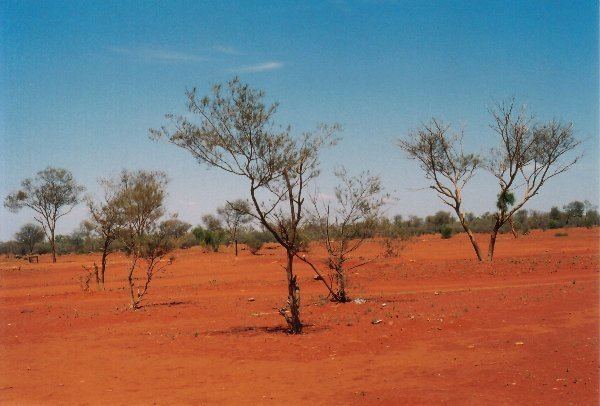 | ||
Utopia is an Aboriginal homeland formed in November 1978 by the amalgamation of the former Utopia pastoral lease with a tract of unalienated land to its north. It covers an area of 3,500 square kilometres, transected by the Sandover River, and lies on a traditional boundary of the Alyawarra and Anmatjirra people, the two language groups which predominate there today. The name is probably a corruption of Uturupa, which means ‘big sand hill’, a region in the north west extremity of the area.
Contents
- History
- Population
- Services and facilities
- Traditional indigenous lifestyle
- Health
- Prohibition
- Art
- Ongoing challenges
- Notable residents
- References
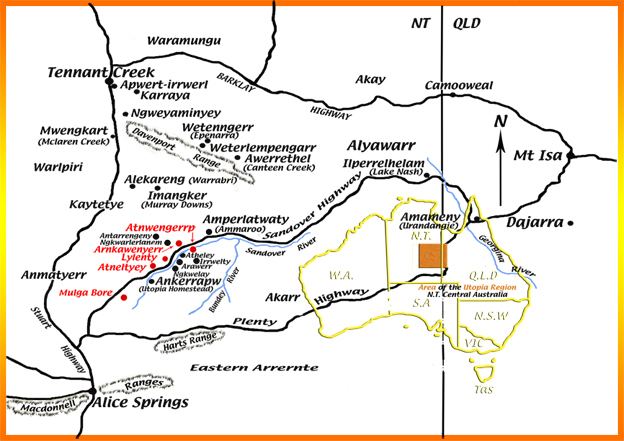
It has a number of unique elements. It is one of a minority of communities created by autonomous activism in the early phase of the land rights movement. It was neither a former mission, nor a government settlement, but was successfully claimed by indigenous people who had never been fully dispossessed. Its people have expressly repudiated any municipal establishment, and instead live in a score of outstations or clan sites, each with a traditional claim to the place.
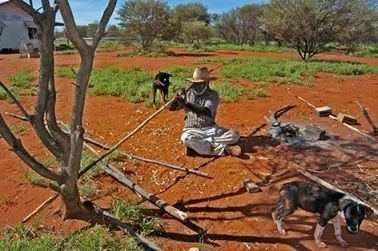
History
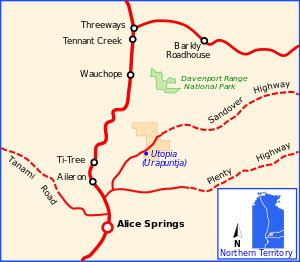
European occupation of the Sandover region began in the early 1880s in the southern Davenport Ranges, then on the Elkedra and the Bundey rivers. These outfits did not have good resources and were short of surface water; most were abandoned by 1895 because of drought and conflict with the Aboriginal inhabitants.

A second phase began in the decade from 1915 to 1925. The two portions which later became Utopia station were first leased by cattlemen in 1928. Relations between the Aborigines and cattlemen appear to have been problematic north of Utopia in Alyawarra/Anmatjirra/Kaititja country, but more cooperative in the south: Utopia, MacDonald Downs, Mt Swan, and Bundey River. The Chalmers family sold the lease of Utopia as a going concern to the Aboriginal Land Fund in 1976. The cattle enterprise had largely lapsed by the time the two land claims were settled in 1978 and 1980.
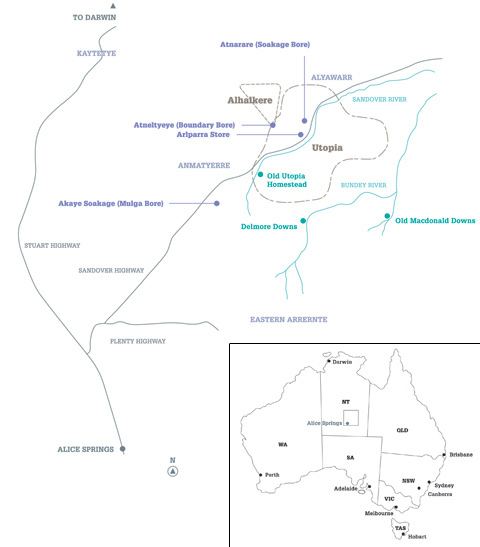
Alyawarra people displaced by the violence during European dispossession fled in significant numbers across Wakaya country to Soudan and Lake Nash on the Barkly Tableland, and to refuges in the east in Kaytete lands and beyond. That is why Utopia people today have close kinship ties with the communities of Ali Carung, Ti-Tree, Harts Range and Lake Nash.
In 2013, Utopia lent its name to, and was a major focus of, a documentary film by John Pilger, highlighting historical and current issues faced by indigenous communities across Australia.
Population
The population at Utopia is a changing quantity, but was roughly 1,200 people in 2011. A typical outstation complement, of which there are 16 communities, is 20–100.
Services and facilities
A community-owned store together with the council offices makes up a sort of municipal centre at the largest outstation, Arlparra. Five small schools are distributed among the outstations, and a bus provides transportation to children who do not live at one of these.
A medical clinic occupies its own site; it is staffed by a doctor, several nurses and a group of local health workers. The clinic delivers most of its services at the outstations by way of a schedule of weekly visits. Funding of essential services is provided by direct Commonwealth grants to the Aboriginal Corporation via the Community Council and the Health Council; both representative bodies are elected by due process annually. The Northern Territory Government provides the educational infrastructure and budgets.
Traditional indigenous lifestyle
The people harvest and consume traditional foods – and to some extent medicines – especially the elders. This practice is likely to have mitigated the prevalence of metabolic diseases, seen in other populations, which have been very damaging to Aboriginal health.
Health
A series of population health surveys carried out between 1986 and 2004, showed that Utopia people were significantly healthier than comparable groups, particularly their rates of mortality. This has been attributed to the more active ‘outstation way of life’. Community living, cultural factors and the primary health care facility were also important factors. This finding is of considerable interest to students of indigenous health. Study of the basis of this difference continues.
In 2014, the borehole supplying water to the community of Utopia was broken during maintenance by Barkly Regional Council, and delivery of water via truck was irregular and insufficient, leading to the spread of disease. While there was dispute by authorities about the extent of the water shortage the Northern Territory government eventually agreed to fund the bore repairs, and money raised by a crowdfunding campaign was transferred to the Urapuntja Health Service.
Prohibition
Alcohol is not permitted anywhere at Utopia, but although the ban is fairly regularly broken, the effects of abuse are intermittent. The problem is minor here compared with many other communities. There is almost no abuse of other intoxicants.
Art
Utopia's Aboriginal artists have been remarkably successful, and continue to produce distinctive works that are collected by people in Australia and all over the world. Notable artists from Utopia include Emily Kame Kngwarreye, Gloria Petyarre, Kathleen Petyarre and Jeanna Petyarre.
Ongoing challenges
The most recent 30-year history of Utopia is a record of self-determination against a background of well-developed communal will and widespread participation. The era of settlement included some profitable relations with white pastoralists and some degree of continuous indigenous occupation. The community has had some success in mitigating the clinical disorders associated with transition to sedentary life, and minimising the advent of destructive behaviours and intoxicants. In addition, they have maintained a strong commitment to traditional practices and customs, which support identity in the face of coercive change. Sanitation issues such as the lack of rubbish collection and poor hygiene are significant obstacles to greater well-being.
To many observers, the outstanding deficiency in remote communities is education; when available, it is seen by the European-Australian society to provide people with capacities for choosing the terms of their integration. Education may work as a powerful integrative force and so shift the issue of cultural identity. The people in Utopia are subject to the tensions of trying to balance these.
